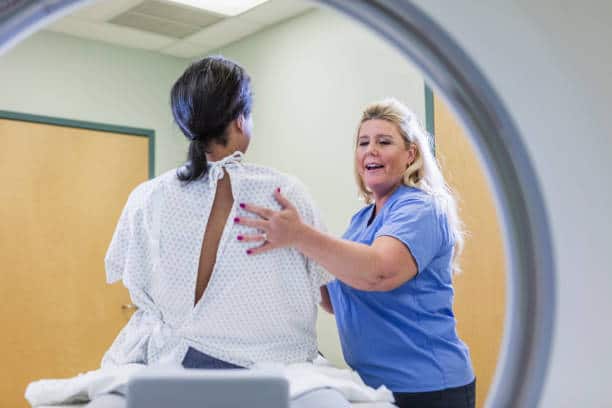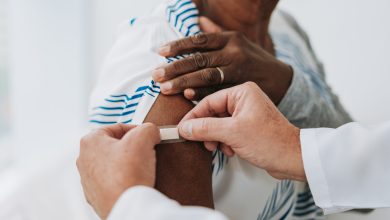Have Dense Breasts? Here’s Why a Standard Mammogram Might Not Be Enough – BlackDoctor.org


Breast cancer is the most common cancer in women globally. In the United States, about one in eight women will be diagnosed with breast cancer at some point in their lives.
Breast cancer screenings—such as self-exams and mammograms—are crucial for detecting the disease in its early stages before it spreads to other parts of the body.
Despite the effectiveness of mammograms, it’s not a one-size-fits-all approach for every woman. New research suggests that more advanced technology is necessary to detect breast cancer cells in women with dense breast tissue.
RELATED: What Are ‘Dense’ Breasts & Why Are They Increasing Your Risk For Breast Cancer?
What Does It Mean to Have Dense Breasts?
Breasts are made of two types of tissue: dense breast tissue and fatty breast tissue. Dense breast tissue includes the milk glands, milk ducts, and supportive tissue, while fatty tissue is made up of fat cells. If you have dense breast tissue, it simply means you have more fibrous or glandular tissue than fat.
Healthcare providers typically categorize breast density into four levels—from almost entirely fatty to extremely dense—using the Breast Imaging Reporting and Data System (BI-RADS).
Dense breasts are common, with about four out of every 10 women having dense breast tissue.
But here’s why that matters:
- Dense tissue can make it difficult to spot cancer. On a mammogram, fatty tissue shows up as dark and transparent, while dense breast tissue appears solid white. Cancer cells also show up white, which means they can easily blend in and be missed.
- Breast density can increase your risk. Women with dense breast tissue have a much higher risk of developing breast cancer than those with more fatty tissue.
It’s important to note that having dense breast tissue doesn’t automatically mean you’ll get breast cancer. However, additional screening is recommended to ensure nothing’s overlooked.

Why Standard Mammograms Don’t Always Tell the Full Story
Traditional 2D mammograms are the first-line breast cancer screening tool, but they have limitations for women with dense breasts. Because dense tissue and tumors can both appear solid white on X-rays, the “masking effect” can hide small cancer cells from view.
For this exact reason, some women are called back to the office for additional imaging after a routine mammogram. It’s not always a cause for concern—it just means providers want a clearer picture of what is (or isn’t) going on.
But for women with dense breast tissue, relying on standard mammograms alone could lead to missed diagnoses or detection at later stages. Ultimately, this delay allows the cancer to spread to other parts of the body and makes it more difficult to treat.
RELATED: Got Dense Breasts? Here’s What the FDA’s New Rule Means for You!
What the Latest Research Says About Advanced Screening
A new study published in Radiology recruited nearly 3,000 women with dense breast tissue—80 percent of whom had no family history of breast cancer—who underwent two years of annual breast screenings between 2017 and 2022. The researchers found that women with dense breast tissue benefit more from advanced screening procedures, such as 3D mammography (digital breast tomosynthesis), breast magnetic resonance imaging (MRI), or molecular breast imaging (MBI).
These methods provide healthcare providers with a clearer view of dense breast tissue, enabling them to detect cancers that 2D mammograms may overlook.
Here’s how these options work:
- 3D mammography: Takes multiple images of the breast from various angles to create a layered, three-dimensional view of the breast. It reduces overlapping tissue and improves cancer detection rates.
- Breast MRI: Uses magnetic fields and contrast dye to create highly detailed images of the breast tissue.
- MBI: A newer technology that uses a small amount of radioactive tracer to highlight abnormal breast tissue that could signal breast cancer.
The research team found that these advanced screenings detected more cancers and had fewer false negatives than standard mammograms in women with dense breasts.
Please note that these procedures may not be suitable for everyone. They can be more expensive, take longer, and may not be covered by your insurance plan. Still, the findings highlight the need for more personalized screening plans—especially for women with dense breast tissue.

What Women with Dense Breasts Should Do Next
If your healthcare provider says that you have dense breasts, don’t panic. Instead, use that information to take a more proactive approach to your health.
Here are a few things you can do:
- Ask your healthcare provider about your breast density: After a mammogram, your imaging report should provide information about your breast density; if it doesn’t, consult your provider directly.
- Discuss your screening options: Ask whether any of the above-mentioned advanced technologies might be more appropriate for you. These tests can help detect breast cancer earlier and more accurately in dense tissue.
- Know your overall risk: Dense breast tissue is just one risk factor for breast cancer. Family history, genetics, and age also play a role.
- Advocate for yourself: If something feels off—even after a standard mammogram—don’t ignore your gut feeling; speak with your healthcare provider.
These tips are essential for Black women, who are more likely to be diagnosed with aggressive forms of breast cancer. Understanding your breast density and receiving proper screening could make a life-saving difference.
Final Thoughts
Having dense breasts is very common and not something to fear—but you should take extra measures to protect your breast health.
Advanced technologies, such as 3D mammograms, breast MRIs, or MBIs, are helping to improve early detection and allow healthcare providers to see what standard mammograms might miss. By learning your breast density, asking questions, and advocating for better imaging, you can take an active role in protecting your health.




